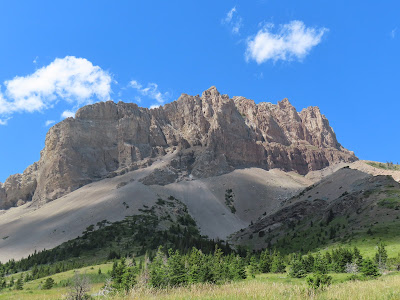 | |
| Gordon Whirry on a CDT precipice below Rodgers Peak |
 |
| Scarlet huckleberries lit up the Rogers Pass Trail |
 |
| The Painted Rocks as Katie walks across the top of the state park dam |
We've been chasing October's spectacular colors as well as making progress on Katie's state parks project.
We visited grandkids in Salt Lake City and hit two state parks on the way there and four on the way back.The parks included: Painted Rocks, Bannack, Clark's Lookout, Beaverhead Rock, Traveler's Rest and Fort Owen.
A week later, two more in the Missoula area, Council Grove and Frenchtown Pond and the St. Mary's Mission (not a state park, but it should be) in Stevensville, as well as.
That brings to more than 30 the parks Katie visited this year out of the 53, leaving 27 to go.
We hiked at each of the parks and then over the past three weeks I climbed Mount Helena and Rodgers Peak on the Continental Divide Trail (twice) .
A highlight of this traveling frenzy was joining the Helena Outdoor Club for an exploration of the Beartrap Gulch trail near York.
I had noticed the trailhead on our yearly visits to the Trout Creek Canyon at Vigilante Campground in the Big Belt Mountains of Helena-Lewis and Clark National Forest, and when the Outdoor Club offered it, I jumped at it.
It follows a tight gulch through a heavy forest of Ponderosa and Doug Fir that opened occasionally into grass.
It was an up and back hike of 9 miles that gained over 3,000 feet in elevation. We got occasional views of limestone spires that mark this area adjacent to the Gates of the Mountains Wilderness.
 |
| Bob Bukantis of York (bearded) was our trip leader |
The hike was led by Bob Bukantis, who lives near York and at age 76 has devoted himself to leading hikes in the York area.
I don't think I've seen a better trip leader. He evenly paces his hikers, keeping them tightly together and grabbing their interest by sharing his deep knowledge of the Big Belts.
The Beartrap Gulch is interesting in that there was once a road for a distance up its gut that has been converted for a way on a trail that parallels the hikers' trail, to accommodate mountain bikers.
Despite this being the opening of rifle season, we encountered no hunters and only one other couple, who was known to our party of eight.
The Painted Rocks State Park was the most unusual of the parks we saw during this period, an impoundment of the West Fork of the Bitterroot River. The "painted rocks" are bright green and yellow vegetation on the headwalls surrounding the canyon and lake.
The drive down the Bitterroot River from Lost Trails Pass was breathtaking for fall colors and wildlife.
We encountered herds of bighorn sheep and near Darby large herds of elk. Likewise, going up the West Fork we saw numbers of elk that were quite casual about our presence.
I figure I've done Rodgers Peak about seven times this hiking season. This past week there was good snow on the peak and adjacent bumps on the CDT. The trail down to Rogers Pass was lit up in spots with scarlet huckleberry bushes.
The state parks tour with Katie would fill a book, so I'll keep it now to the destination hikes.
 |
| The courthouse at Bannack State Park |













































